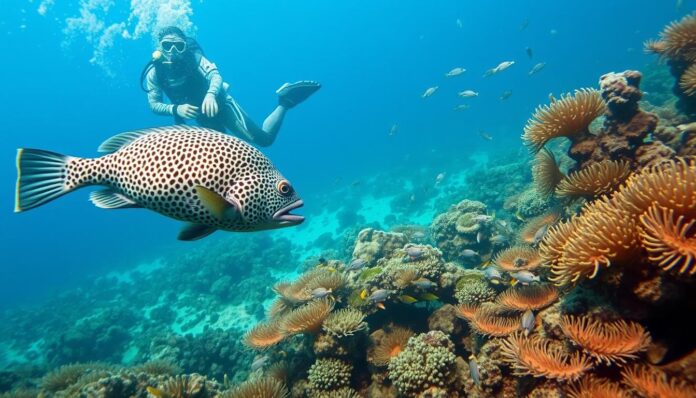Imagine seeing a marine giant as big as a small car underwater! Goliath groupers can grow up to 800 pounds. This makes your scuba diving with groupers an unforgettable underwater adventure.
Diving with groupers gives you a unique look into the underwater world. These amazing creatures live in warm waters. They offer divers a chance to see marine life up close.
Scuba diving with groupers is more than just a dive. It’s a journey to learn about these incredible sea creatures. From their huge size to their complex social lives, groupers are truly fascinating.
Key Takeaways – Diving with Groupers
- Goliath groupers can grow up to 10 feet long
- Diving locations include Florida’s offshore reefs
- Best diving seasons are late July through October
- Spawning occurs during new moon phases
- Advanced diving certification recommended
What Are Groupers?
Diving into the world of marine life reveals a fascinating creature. Groupers dominate tropical and subtropical coral reefs. They are remarkable fish that capture the imagination of underwater explorers.
These marine creatures are known for their distinctive traits. Exploring coral reefs with them is an unforgettable experience. Groupers are slow-moving, curious, and intelligent, making them a favorite among marine biologists and diving enthusiasts.
Overview of Grouper Characteristics
Groupers belong to an impressive family. They have some remarkable statistics:
- More than 160 recognized species in the Epinephelinae subfamily
- Can grow up to 2.5 meters (8.2 feet) in length
- Potential weight of up to 1,000 pounds
- Typical lifespan of up to 50 years
Different Species of Groupers
The diversity of grouper species is truly remarkable. From the vibrant coral groupers with their striking red coloration and blue spots to the massive Goliath groupers, each species offers a unique marine life encounter.
| Species | Key Characteristics | Habitat |
|---|---|---|
| Coral Grouper | Red color, blue spots | Red Sea, Western Thailand, Raja Ampat |
| Goliath Grouper | Massive size, deep reef dweller | Palm Beach Coast, Deep Reefs |
| Marbled Grouper | Spawning aggregations | French Polynesia’s Tuamotu Archipelago |
A fascinating fact about groupers is their unique reproductive strategy: they are protogynous hermaphrodites, starting life as females and transitioning to males to access new territories and mating opportunities.
For divers and marine enthusiasts, understanding these incredible creatures adds depth to underwater adventures. It transforms a simple dive into an educational and awe-inspiring experience.
The Best Locations for Diving with Groupers
Diving in Florida Keys is a top choice for those who love underwater adventures. It’s known for amazing grouper sightings. The area’s marine life makes it perfect for exploring these creatures.
South Florida is the best place for grouper diving. Jupiter and Palm Beach are highlights for their incredible marine life. They offer unique experiences for underwater explorers.
Top Dive Spots for Grouper Encounters
- Boynton Beach Castor Wreck: Home to over 130 Goliath groupers
- Palm Beach County Corridor: Features six interconnected wreck dive sites
- Zion Train/Bonaire wreck site: Documented 90+ individual Goliath groupers in 2012
Asia:
- Maldives: The Maldives is renowned for its stunning coral reefs and abundant marine life. Groupers, including the giant grouper, can be found in the clear waters surrounding the atolls, providing unforgettable encounters for divers.
- Indonesia: With its vast archipelago and diverse marine ecosystems, Indonesia offers exceptional diving opportunities. Destinations such as Raja Ampat, Komodo National Park, and Bali are known for their thriving grouper populations.
- Thailand: Thailand’s Andaman Sea and Gulf of Thailand are home to beautiful dive sites where divers can encounter groupers. The Similan Islands, Koh Phi Phi, and the Surin Islands are popular locations to explore their underwater realms.
- Egypt: The Red Sea in Egypt boasts remarkable dive sites, including the renowned Ras Mohammed National Park and the SS Thistlegorm wreck. Here, divers can encounter groupers amidst colorful coral reefs and vibrant marine life.
- Mozambique: Mozambique’s coastline is dotted with pristine dive spots offering encounters with groupers. The reefs of Tofo, Ponta do Ouro, and the Quirimbas Archipelago provide opportunities to dive alongside these magnificent creatures.
- Cayman Islands: The Cayman Islands in the Caribbean are known for their exceptional diving. Sites like the Bloody Bay Marine Park in Little Cayman and the Kittiwake wreck in Grand Cayman attract divers with their grouper populations.
- Bahamas: The Bahamas is a haven for divers, with its crystal-clear waters and thriving marine life. From the Andros Barrier Reef to the Exuma Cays, divers can explore stunning reefs and swim alongside groupers.
- Belize: Belize’s Barrier Reef, a UNESCO World Heritage Site, offers diverse dive sites teeming with marine life. The Great Blue Hole, Turneffe Atoll, and Glover’s Reef are popular spots to encounter groupers and explore the underwater wonders.
- Costa Rica: Costa Rica’s Pacific coast is known for its rich marine biodiversity. Dive sites such as Cocos Island, Bat Islands, and Cano Island attract divers seeking encounters with groupers amidst stunning underwater landscapes.
- Greece: The waters surrounding the Greek islands provide opportunities to dive with groupers. Destinations such as Crete, Santorini, and Zakynthos offer a combination of historical sites and vibrant marine ecosystems.
- Spain: The Canary Islands, specifically Tenerife and Gran Canaria, are known for their volcanic seascapes and diverse marine life. Diving enthusiasts can explore these underwater playgrounds alongside groupers.
- Australia: Australia’s Great Barrier Reef, the world’s largest coral reef system, offers extraordinary diving experiences. Locations like the Ribbon Reefs, Cod Hole, and the Coral Sea are renowned for their grouper populations.
- Palau: Palau, in the western Pacific Ocean, is famous for its pristine reefs and diverse marine species. Divers can encounter groupers while exploring the stunning dive sites of Blue Corner, German Channel, and Ulong Channel.
- Florida, USA: Florida is home to the Florida Keys, where divers can explore the diverse marine ecosystems of the Florida Keys National Marine Sanctuary. Dive sites like Looe Key and the Dry Tortugas offer encounters with groupers.
- Mexico: Mexico’s Yucatan Peninsula offers world-class diving opportunities in locations such as Cozumel, Cancun, and Tulum. The Mesoamerican Barrier Reef System is home to groupers and a myriad of other marine species.
- Galapagos Islands, Ecuador: The Galapagos Islands are renowned for their unique and abundant marine life. Divers can encounter groupers, including the iconic Galapagos grouper, amidst the volcanic seascapes of this extraordinary archipelago.
- Brazil: Brazil’s Fernando de Noronha archipelago, a UNESCO World Heritage Site, is a haven for divers. Here, divers can explore the marine park’s protected waters, encounter groupers, and marvel at the region’s underwater biodiversity.
These destinations offer incredible opportunities to dive with groupers and explore their natural habitats. However, it is important to be mindful of local regulations, seasons, and environmental conservation practices when diving in these areas. Respect the marine life and contribute to the preservation of these remarkable ecosystems, ensuring that future generations can also enjoy the thrill of diving with groupers.
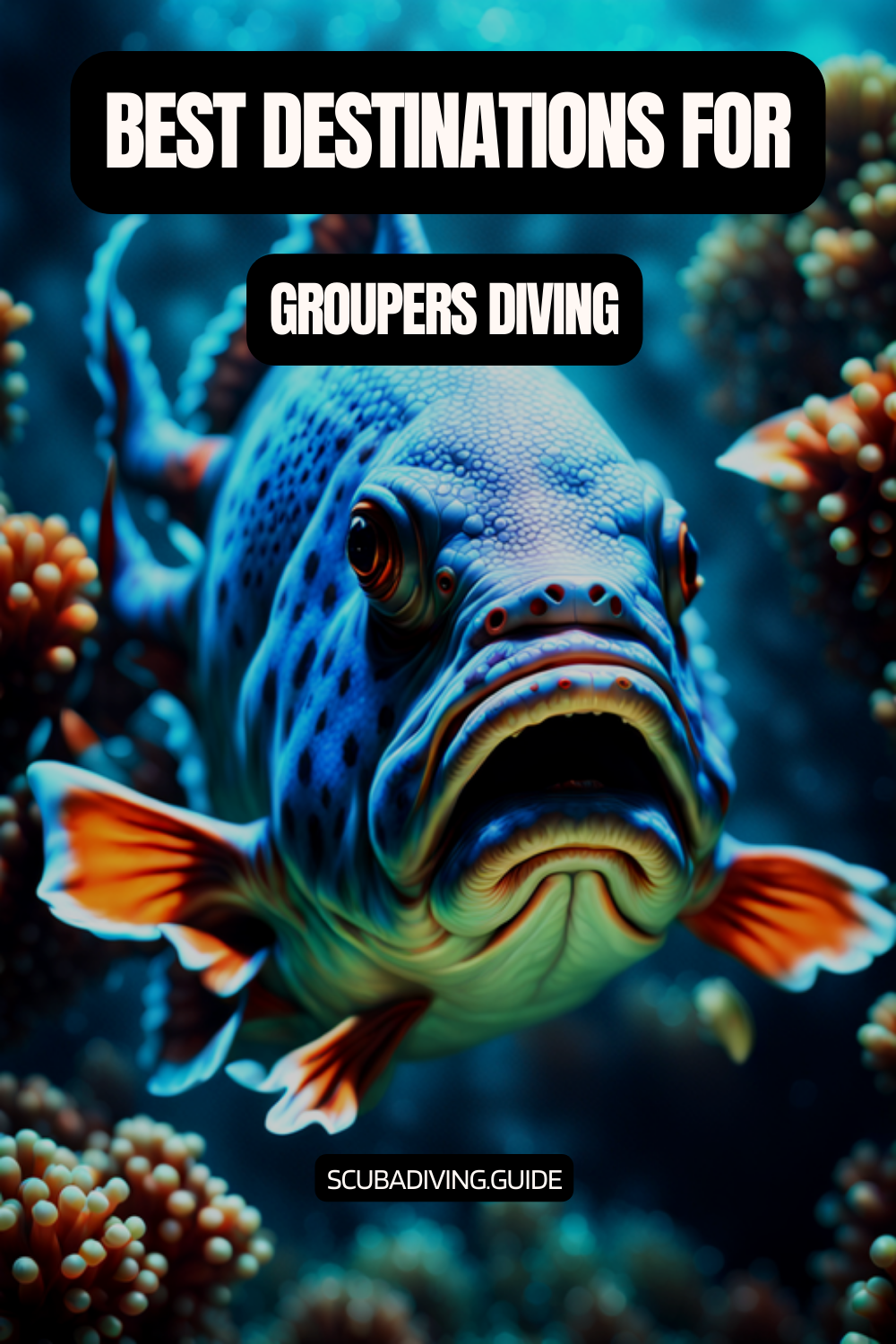
Seasonal Considerations for Grouper Diving
When diving, it’s important to follow sustainable tourism. The best time to see groupers is in August and September. This is when they spawn, making it the best time to see them.
| Location | Peak Season | Typical Grouper Count |
|---|---|---|
| Hole-in-the-Wall | August-September | 27-40 fish |
| Boynton Beach | August-September | 65-130 fish |
| Palm Beach Corridor | August-September | 90+ fish |
“The Gulf Stream creates an incredible marine environment that supports these magnificent grouper populations.” – Marine Biologist
Goliath groupers can travel up to 350 miles to spawn. They dive between 20 to 30 meters. This makes for challenging but rewarding dives.
When planning your dive in Florida Keys, know each spot’s unique features. The Ana Cecilia wreck is a 52-meter cargo ship. It’s a great dive site with lots of marine life.
Preparation for Your Dive Trip
Starting a scuba certification course needs careful planning. You must know the basics of diving. A great dive with groupers depends on good planning, the right gear, and safety knowledge.
Diving with groupers requires special skills and gear. Divers should look for scuba courses that teach both theory and practical skills.
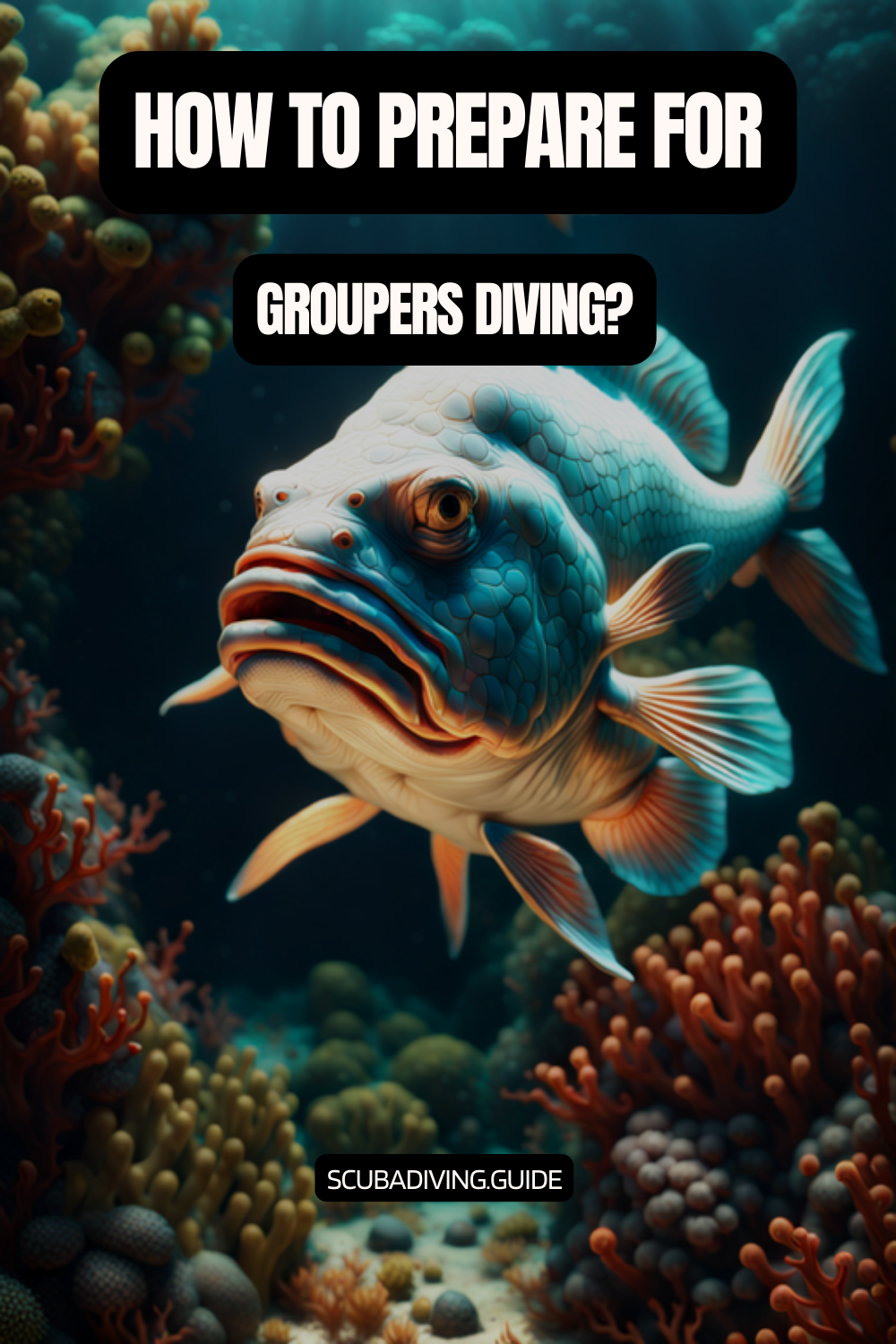
Essential Scuba Gear for Diving
Choosing the right diving gear is key for a safe and fun dive. Here are the must-haves for every diver:
- Mask with anti-fog coating
- Wetsuit suitable for the water temperature
- Buoyancy control device (BCD)
- Dive computer
- Regulators with backup systems
Safety Tips for Group Diving
“Preparation is the key to a successful and safe diving experience.”
Scuba courses teach vital safety rules. Knowing how to dive with a group is essential for a safe dive.
| Safety Recommendation | Description |
|---|---|
| Buddy System | Stay within 5-10 feet of your diving partner |
| Depth Awareness | Always check your depth and dive computer |
| Communication | Use standard underwater hand signals |
| Emergency Preparedness | Have a backup air source and safety gear |
Recommended dive operators like Kyalami Charters offer grouper diving in South Florida. They provide expert advice for enthusiasts.
Good preparation through scuba courses lets divers explore safely. They can enjoy the underwater world while respecting marine life.
The Experience of Diving with Groupers
Scuba diving with groupers is an amazing experience. It turns underwater exploration into a thrilling adventure. These incredible creatures make unforgettable moments for divers.
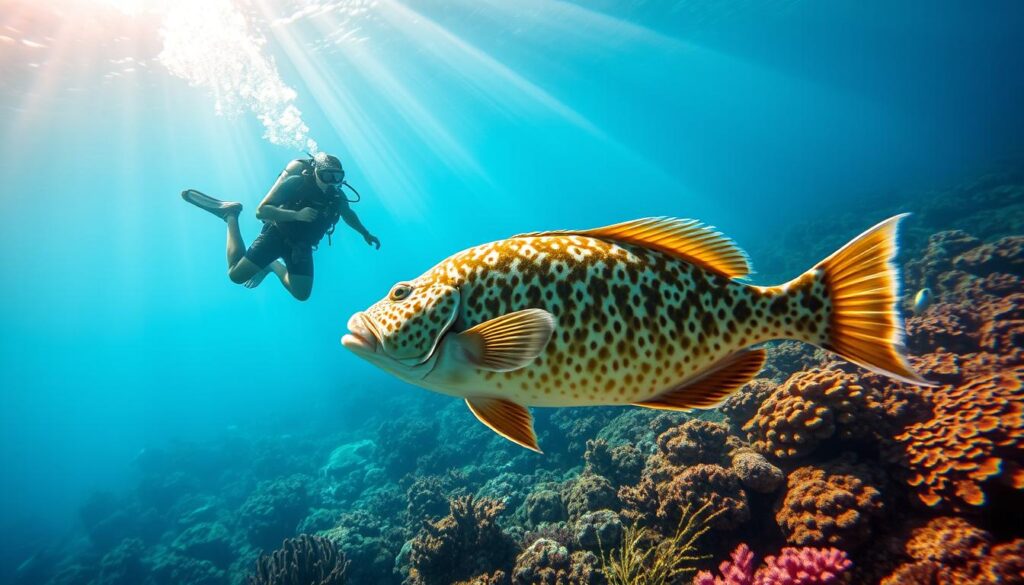
Divers can expect amazing interactions with grouper fish. This is true during their seasonal gatherings. The Goliath grouper, which can weigh up to 800 lbs, is a sight to behold in their natural home.
What to Expect Underwater
When diving with groupers, you enter a world of fascinating marine behavior. Grouper fish behavior changes based on location and season. In peak times, from late July to October, divers might see dozens of Goliath groupers in certain reef areas.
- Visibility ranges typically between 15-25 feet
- Potential encounters with multiple grouper species
- Opportunities to observe complex marine ecosystems
Interacting with Groupers
Responsible marine life encounters need understanding and respect. Divers should keep a safe distance and not disturb these impressive fish. Here are some key guidelines:
- Observe without touching
- Move slowly and deliberately
- Respect their natural habitat
“The ocean’s greatest mysteries unfold when we approach with reverence and curiosity.” – Marine Exploration Team
Experienced divers suggest hiring local guides who know grouper territories. This helps ensure safety and understanding of these remarkable creatures.
| Grouper Characteristic | Details |
|---|---|
| Maximum Weight | 800 lbs |
| Peak Aggregation Season | Late July – October |
| Typical Dive Visibility | 15-25 feet |
Conservation Efforts for Groupers
Protecting marine ecosystems is key, and it needs focused efforts. These efforts must balance tourism with protecting wildlife. Groupers are vital for keeping the ocean’s balance, making their protection essential for marine life.
The Ecological Significance of Groupers
Groupers are vital to the ocean, with some like the Atlantic Goliath Grouper growing up to 8 feet and weighing 800 pounds. They are more than just big fish:
- Maintain reef ecological balance
- Control population of smaller marine species
- Serve as indicators of marine ecosystem health
Responsible Diving Practices
Sustainable tourism is key to protecting groupers. Divers can help by following these tips:
- Minimize underwater disturbance
- Never touch or feed marine life
- Participate in marine conservation programs
- Support local conservation initiatives
“Every dive is an opportunity to become a steward of marine conservation” – Marine Biologist Research Team
The Volunteer Fish Survey Project and Grouper Moon Project show how to protect groupers. These efforts have greatly helped endangered grouper populations. They show that working together can greatly help preserve marine ecosystems.
Groupers and Their Behavior
Diving into the world of marine life, we find grouper fish fascinating. They live in complex underwater worlds. Their social structures and feeding habits are truly captivating.
Social Dynamics of Underwater Communities
Grouper fish are incredibly smart socially. They form complex social networks. This includes:
- Hierarchical territorial arrangements
- Complex communication through body language
- Strategic group interactions during feeding
“Groupers are not just fish, they’re sophisticated marine architects of underwater society.”
Hunting and Feeding Strategies
Marine life encounters with groupers show amazing hunting skills. Goliath groupers chase baitfish with incredible precision. Their feeding habits include:
- Ambush hunting near reef structures
- Collaborative hunting with surrounding marine species
- Strategic positioning to maximize prey capture
During spawning seasons, groupers show incredible behavior. Some species gather in huge numbers. Up to 150 individuals have been seen at specific sites during peak times.
Learning about grouper fish behavior opens a window into the complex marine world. It’s truly mesmerizing.
Underwater Photography Tips
Capturing the world of groupers underwater needs special skills. Divers want to keep their amazing encounters with these sea creatures alive through photos.
Underwater photography is tough. It requires technical knowledge and preparation. Sadly, only 27% of divers test their camera before diving. Knowing your gear before you dive is key.
Capturing Images of Groupers
Here are some tips for taking grouper photos:
- Stay close, within 1 meter, for clear shots
- Wide-angle lenses are best, used by 60% of photographers
- Control your buoyancy to avoid shaking the water
- Adjust your white balance every 5-10 feet in light changes
Best Equipment for Underwater Photography
Choosing the right gear is vital for great photos. Pros suggest:
| Equipment | Recommended Specifications |
|---|---|
| Camera Housing | Waterproof to at least 100 feet |
| Strobe Lighting | Color temperature 4500-4800K |
| Lens Type | Wide-angle or macro, depending on subject |
| Memory Card | Multiple backups to prevent data loss |
“Getting close to the subject creates better images” – 80% of underwater photographers
Do a thorough check before diving to avoid flooding. Regular upkeep can cut down on gear failure by 40%. This way, your grouper photos will be unforgettable.
Educational Opportunities
Diving with groupers is more than just fun. It’s a chance to learn about marine life through scuba courses and encounters. It turns a hobby into a deep understanding of the ocean.
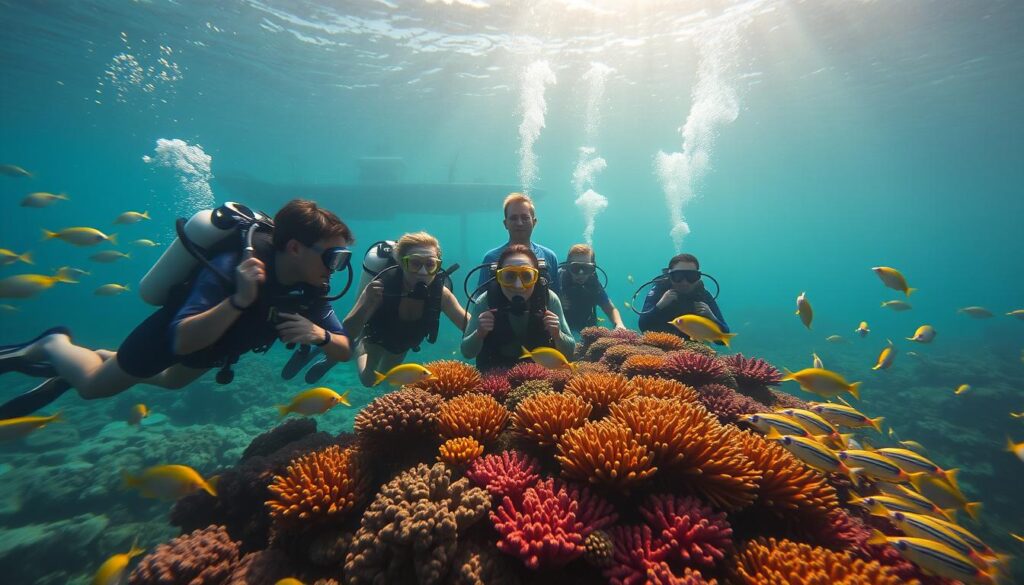
The Grouper Moon Project is a great learning chance for ocean lovers. It shows how to protect marine life and study groupers.
Learning Marine Biology Through Diving
Marine biology workshops are amazing for learning about the sea. They mix science with hands-on experiences.
- Attend live stream sessions focused on marine research
- Explore educational resources from REEF
- Participate in conservation-oriented scuba certification courses
Specialized Workshops and Courses
Florida has many diving courses for learning:
- Beginner marine life identification courses
- Advanced underwater research workshops
- Conservation-focused marine biology programs
“Every dive is a learning opportunity to understand and protect our marine ecosystems.”
The Grouper Moon Project shows how diving helps science. It offers learning for all ages, making marine science fun and easy to understand.
Key Learning Resources
Divers can find free learning materials at REEF. They include documentaries like “Changing Seas” and “Grouper Moon: The Next Phase”. These teach a lot about marine conservation and grouper studies.
Diving Tours and Packages
Exploring the underwater world of groupers needs careful planning. You must choose the right diving tour. Scuba diving with Groupers is an extraordinary experience that requires thoughtful preparation and expert guidance.
Diving enthusiasts looking to see these magnificent marine creatures have many options. They can choose from incredible Florida Keys diving adventures. Professional tour operators offer memorable underwater experiences for all skill levels.
Choosing the Right Diving Company
When picking a diving tour for grouper encounters, consider these key factors:
- Years of experience in marine expeditions
- Specialized knowledge of grouper habitats
- Safety certifications and professional credentials
- Group size and instructor-to-diver ratio
Understanding Tour Inclusions
Diving packages vary in what they offer. Most include:
- Professional guide services
- Equipment rental
- Transportation to diving locations
- Underwater photography opportunities
“The right diving package transforms an ordinary trip into an extraordinary marine adventure.” – Marine Exploration Magazine
For those passionate about scuba diving with Groupers, researching tour options is key. Prices range from $1,192 to $18,500. Most specialized grouper tours average around $5,088.
Package Pricing Insights
When choosing a diving tour, consider these factors:
- Duration: Most specialized tours last 10-13 days
- Group Size: Luxury experiences typically accommodate 8 guests
- Expertise: Look for tours led by experienced marine photographers
Pro tip: Book early and take advantage of possible discounts. For example, get $75 off for full payment before July 1st. This ensures your dream grouper diving adventure becomes a reality.
Recommended Certifications for Diving
Diving with groupers is more than just fun. You need professional scuba certification courses. These courses teach you the skills and knowledge for safe and responsible diving. Whether you’re new or experienced, knowing the right certifications can make your diving better.
Essential Scuba Certifications for Beginners
Beginners start with foundational scuba certification courses. These programs teach the basics of diving:
- Open Water Diver Certification – The basic entry-level qualification
- Basic underwater navigation skills
- Emergency response training
- Equipment management techniques
Advanced Diving Specialties for Experienced Divers
Experienced divers can dive deeper with specialized courses:
- Deep Diving Certification
- Advanced Open Water Certification
- Fish Identification Specialty
- Underwater Photography Course
“The right certification doesn’t just teach skills—it opens entire underwater worlds.” – Professional Diving Instructor
Getting the right scuba certification courses prepares you. It makes you confident and ready to explore marine environments like grouper habitats safely.
Personal Stories of Diving Adventures
Scuba diving with Groupers is a thrilling experience. It leaves divers amazed and filled with wonder. Every dive is a unique story of connection and discovery under the sea.
Memorable Encounters with Groupers
Divers worldwide have shared incredible stories. These tales show the magic of marine life. They reveal the fascinating world of groupers in their natural home.
- Witnessing massive Goliath groupers during spawning events
- Getting within inches of these magnificent creatures during feeding frenzies
- Observing their complex social behaviors underwater
“I’ve dove with many marine species, but nothing compares to the moment a massive grouper looks directly into your eyes,” says marine biologist Dr. Sarah Roberts.
Testimonials from Experienced Divers
Seasoned divers say diving with groupers is life-changing. These underwater giants can weigh up to 800 pounds and reach 10 feet long. They leave lasting memories.
- Divers have seen up to 50 Goliath groupers around underwater wrecks
- The best time to see them is between August and September, during spawning season
- Special dive charters offer great chances to meet these amazing creatures
Every dive is a personal story of discovery and respect. It’s a chance to connect with the incredible marine world groupers inhabit.
FAQs About Scuba Diving with Groupers
Planning your first scuba diving with Groupers adventure can spark numerous questions. These massive marine creatures may seem intimidating. But, understanding their behavior makes snorkeling with Groupers an exciting experience. Goliath Groupers, weighing up to 800 pounds and measuring 8 feet long, are actually quite docile during most encounters.
For first-time divers interested in underwater exploration, several key considerations emerge. The Out to Sea Shark Dive offers unique opportunities for non-certified divers to safely encounter these remarkable fish. Experienced guides recommend maintaining a respectful distance, as Goliath Groupers can exhibit territorial behaviors during their mating season from August to October.
Essential Questions for Divers
When preparing for scuba diving with Groupers, understanding their ecosystem is key. These marine giants spend their early years in mangrove systems before migrating to coral reefs. Divers should practice proper buoyancy control and remain calm, as Goliath Groupers communicate through unique vocalizations that can sound like “barking” when feeling threatened.
Tips for Safe Underwater Encounters
Safety remains the top priority during snorkeling with Groupers. Despite their size, these creatures are classified as critically endangered and require careful approach. Always follow professional guidance, respect their natural habitat, and remember that these apex predators play a vital role in marine ecosystems by controlling populations of crustaceans and smaller marine life.
Common Marine Species Found Alongside Groupers
Diving with groupers often provides the opportunity to encounter a diverse array of marine life that coexists within their habitat. These species create a vibrant underwater ecosystem, adding to the allure and fascination of diving with groupers. Let’s explore some of the common marine species that are often found alongside groupers:
- Reef Fish: Groupers and reef fish share the same habitats, making them frequent companions during dives. Colorful species such as angelfish, butterflyfish, parrotfish, and surgeonfish can be spotted swimming gracefully among the corals. Their vibrant colors and intricate patterns create a mesmerizing underwater tapestry.
- Moray Eels: Moray eels are often found residing in the same rocky crevices and caves that groupers prefer. These long, serpentine creatures with their prominent jaws and sharp teeth add an element of intrigue to the underwater landscape. Divers may encounter green morays, spotted morays, or even the elusive and iconic giant moray.
- Triggerfish: Triggerfish are a common sight around coral reefs, and their vibrant colors and distinct body shapes make them stand out. These feisty fish, known for their territorial behavior, may occasionally interact with groupers. Divers might encounter species such as Picasso triggerfish, titan triggerfish, or clown triggerfish.
- Snappers: Snappers often share similar habitats with groupers, forming schools or aggregations in certain areas. These sleek and streamlined fish are known for their speed and agility. Some common snapper species encountered during groupers dives include red snapper, dogtooth snapper, and mangrove snapper.
- Barracudas: Barracudas are known for their sleek bodies, sharp teeth, and formidable presence in the water. They are often seen patrolling the reef or lurking in open water. While groupers and barracudas do not typically interact, spotting a barracuda in the vicinity adds an element of excitement to the dive.
- Turtles: Sea turtles are charismatic creatures that divers often encounter during groupers dives. These gentle giants gracefully navigate through the water, occasionally pausing to rest or feed. Spotting a green turtle, hawksbill turtle, or loggerhead turtle alongside groupers adds to the sense of wonder and appreciation for marine biodiversity.
- Rays: Various species of rays can be found gliding effortlessly across the seafloor or soaring through the water column. Stingrays, eagle rays, and manta rays are among the species that may be encountered during groupers dives. Their graceful movements and distinctive shapes make for captivating underwater encounters.
- Reef Sharks: Depending on the dive location, divers may occasionally come across reef sharks such as blacktip sharks, whitetip sharks, or nurse sharks. These apex predators play an important role in maintaining the balance of the ecosystem. Observing them from a safe distance provides a thrilling glimpse into the marine food chain.
- Invertebrates: The reefs and rocky formations that groupers inhabit are also home to an array of fascinating invertebrates. Colorful nudibranchs, delicate sea fans, intricate corals, and elusive octopuses are just a few examples of the mesmerizing invertebrate life that can be encountered during groupers dives.
- Pelagic Species: Depending on the dive location and oceanic conditions, divers may have the opportunity to encounter pelagic species such as tuna, trevally, or even dolphins. These pelagic visitors add an unexpected and thrilling element to the dive, providing a glimpse into the vastness and diversity of the open ocean.
Encountering these common marine species alongside groupers enriches the overall diving experience. Observing the interactions and relationships between different species enhances our understanding of the intricate web of life that exists beneath the waves. It reminds us of the interconnectedness of marine ecosystems and the importance of preserving their biodiversity for future generations to enjoy.
FAQ – Diving with Groupers
What makes groupers unique among marine species?
Groupers are amazing marine animals known for their large size and color-changing abilities. They can grow up to 800 pounds, like the Goliath Grouper. Their ability to change color helps them hide and communicate in coral reefs.
Are groupers dangerous to divers?
Groupers are usually gentle and not aggressive towards humans. They might approach divers out of curiosity. It’s important to keep a safe distance and follow diving rules for everyone’s safety.
What is the best time of year to dive with groupers?
In the Florida Keys, late summer and early fall are the best times. This is when many groupers gather for spawning. It’s a great chance to see these fish in their natural setting.
What certifications do I need to dive with groupers?
You need at least an Open Water Diver certification for grouper diving. Depending on where you dive, you might need more advanced certifications. Always check with local dive operators for specific requirements.
How can I photograph groupers underwater?
Photographing groupers underwater takes patience and the right gear. Use a camera that works well in low light, a wide-angle lens, and external strobes. Focus on their texture, size, and the reef around them for great photos.
Are groupers endangered?
Yes, some grouper species are threatened by overfishing and habitat loss. The Goliath Grouper is critically vulnerable. It’s important to support conservation and dive responsibly to protect these species and coral reefs.
What equipment do I need for grouper diving?
You’ll need a wetsuit, mask, fins, dive computer, and scuba gear. Depending on the water temperature, you might need a thicker wetsuit or even a drysuit. Make sure your gear is in good condition and suitable for the dive site.
Can beginners dive with groupers?
Yes, but with proper guidance. Many dive operators offer beginner experiences. Beginners should dive with a certified guide, follow safety rules, and choose calm, clear locations.
How close can I get to a grouper?
Keep at least 10-15 feet away from groupers. Getting too close can stress them. Use photography techniques that let you capture great shots without disturbing them.
What do groupers typically eat?
Groupers are opportunistic predators that eat smaller fish, crustaceans, and squid. They ambush their prey, using their large mouths to suck it in. Their diverse diet helps keep coral reefs healthy.
